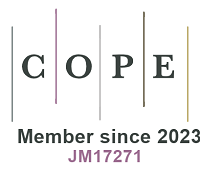A new era for Emerging Contaminants and Environmental Health
Water Emerging Contaminants & Nanoplastics (WECN) was first published in March 2022 under the leadership of its Founding Editor, Dr. Antonio Ginebreda. In 2024, Dr. Daoji Li and Dr. Joana C. Prata were appointed Co-Editors-in-Chief. Currently, the Editorial Board comprises 67 members representing 18 countries worldwide. WECN was established to address two rapidly evolving fields: emerging contaminants in water and micro- and nanoplastics, along with their effects on ecosystems and human health. This vision has proven successful, with 79 articles published to date. In addition, WECN has been highly active in organizing webinars, academic talks, and supporting scientific events.
Impactful studies published in WECN have highlighted critical issues, such as the underestimation of black microplastics in the environment (10.20517/wecn.2022.10), the association between microplastics and per- and polyfluoroalkyl substances (PFASs) (10.20517/wecn.2023.25), and the environmental risks posed by biodegradable plastics (10.20517/wecn.2022.11). The journal’s commitment to high-quality science and rigorous editorial standards was recognized in 2024 with its inclusion in Scopus, earning a CiteScore of 3.8. Published works span a broad range of fields, including Materials Science (Miscellaneous), Waste Management and Disposal, Polymers and Plastics, Toxicology, and Environmental and Occupational Public Health.
However, the journal’s current scope does not always fully reflect the breadth of topics addressed by submitted articles, which increasingly extend beyond water contaminants and microplastics. The global rise in environmental degradation has heightened the urgency to monitor emerging contaminants and their health impacts. Supporting this trend, Scopus data show a 26% and 28% rise in publications with “Emerging Contaminants” and “Environmental Health” in their titles, abstracts, or keywords between 2022 and 2024, respectively.
In response to these evolving research trends, the journal will adopt a new direction and rebrand as Emerging Contaminants and Environmental Health (EHEC). While continuing to welcome submissions on its foundational topics - particularly microplastics as a key emerging contaminant - the journal will expand its scope to embrace broader themes across Environmental Sciences and Human Health. This shift aims to serve our authors better and promote an integrative, interdisciplinary understanding of the complex interactions between contaminants and public health. EHEC will remain committed to publishing high-quality research and supporting authors by maintaining a competitive acceptance rate of 35% and a mean submission-to-publication time of 45 days. Moving forward, the journal will actively engage a diverse range of professionals. With your continued support, EHEC aspires to become a leading reference in the field in the coming years.
DECLARATIONS
Authors’ contributions
The author contributed solely to the article.
Availability of data and materials
Not applicable.
Financial support and sponsorship
None.
Conflicts of interest
Prata, J. C. is Editor in Chief of the journal Water Emerging Contaminants & Nanoplastics. Prata, J. C. was not involved in any steps of editorial processing, notably including reviewers’ selection, manuscript handling and decision making. Prata, J. C. declares that there are no conflicts of interest.
Ethical approval and consent to participate
Not applicable.
Consent for publication
Not applicable.
Copyright
© The Author(s) 2025.
Cite This Article
How to Cite
Download Citation
Export Citation File:
Type of Import
Tips on Downloading Citation
Citation Manager File Format
Type of Import
Direct Import: When the Direct Import option is selected (the default state), a dialogue box will give you the option to Save or Open the downloaded citation data. Choosing Open will either launch your citation manager or give you a choice of applications with which to use the metadata. The Save option saves the file locally for later use.
Indirect Import: When the Indirect Import option is selected, the metadata is displayed and may be copied and pasted as needed.
About This Article
Copyright
Data & Comments
Data















Comments
Comments must be written in English. Spam, offensive content, impersonation, and private information will not be permitted. If any comment is reported and identified as inappropriate content by OAE staff, the comment will be removed without notice. If you have any queries or need any help, please contact us at [email protected].